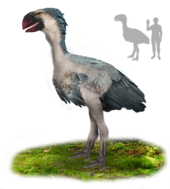Gastornis
Gastornis is an extinct genus of large flightless birds that lived during the mid Paleocene to mid Eocene epochs of the Paleogene period. Fossils have been found in Europe, Asia and North America, with the remains from North America originally assigned to the genus Diatryma.
Gastornis species were very large birds, and have traditionally been considered to be predators of small mammals. However, several lines of evidence, including the lack of hooked claws in known Gastornis footprints and studies of their beak structure and isotopic signatures of their bones have caused scientists to reinterpret these birds as herbivores that probably fed on tough plant material and seeds. Gastornis is generally agreed to be related to Galloanserae, the group containing waterfowl and gamebirds.
Gastornis was first described in 1855 from a fragmentary skeleton. It was named after Gaston Planté, described as a "studious young man full of zeal", who had discovered the first fossils in clay (Argile Plastique) formation deposits at Meudon near Paris.[2] The discovery was notable due to the large size of the specimens, and because, at the time, Gastornis represented one of the oldest known birds.[3] Additional bones of the first known species, G. parisiensis, were found in the mid 1860s. Somewhat more complete specimens, this time referred to the new species G. eduardsii (now considered a synonym of G. parisiensis) were found a decade later. The specimens found in the 1870s formed the basis for a widely circulated and reproduced skeletal restoration by Lemoine. The skulls of these original Gastornis fossils were unknown except for nondescript fragments, and several bones used in Lemoine's illustration turned out to be those of other animals.[4] Thus, the European bird was long reconstructed as a sort of gigantic crane-like bird.[5][6]
In 1874, the American paleontologist Edward Drinker Cope discovered another fragmentary set of fossils in the Wasatch Formation of New Mexico. He considered them to belong to a distinct genus and species of giant ground bird, which, in 1876, he named Diatryma gigantea (/ˌdaɪ.əˈtraɪmə/ DY-ə-TRY-mə),[7] from Ancient Greek διάτρημα, diatrema, meaning “through a hole”, referring to the large foramina (perforations) that penetrate some of the foot bones.[8][9] A single gastornithid toe bone from New Jersey was described by Othniel Charles Marsh in 1894 and classified as the new genus and species Barornis regens, but in 1911 it was recognized that this, too, could be considered a junior synonym of Diatryma (and therefore later Gastornis).[10] Additional fragmentary specimens were found in Wyoming in 1911 and assigned in 1913 to the new species Diatryma ajax (also now considered a synonym of G. gigantea).[10] In 1916, an American Museum of Natural History expedition to the Bighorn Basin (Willwood Formation) of Wyoming found the first nearly complete skull and skeleton, which was described in 1917 and gave scientists their first clear picture of the bird.[10] Matthew, Granger, and Stein (1917) classified this nearly complete specimen as yet another new species, Diatryma steini.[10]


